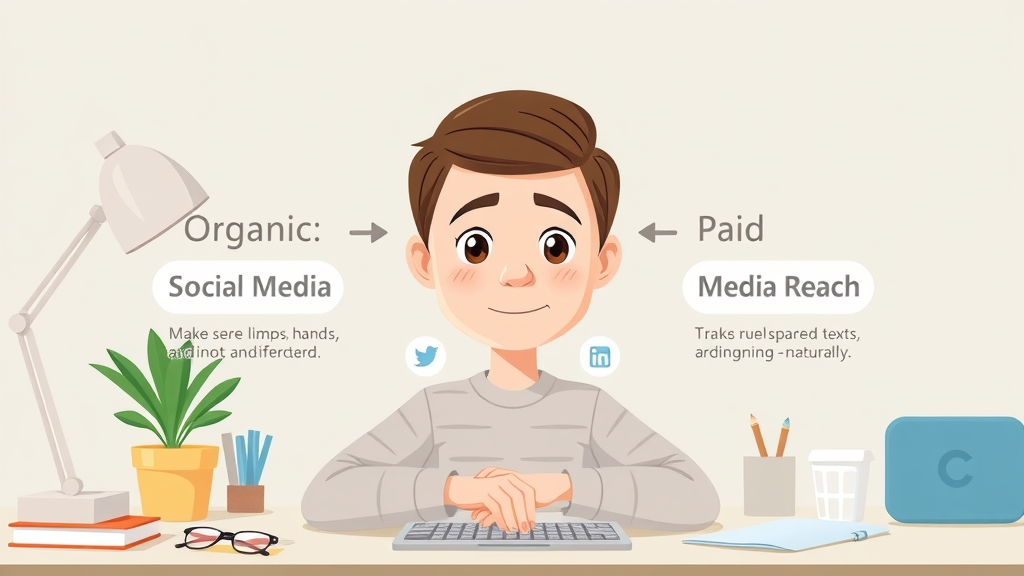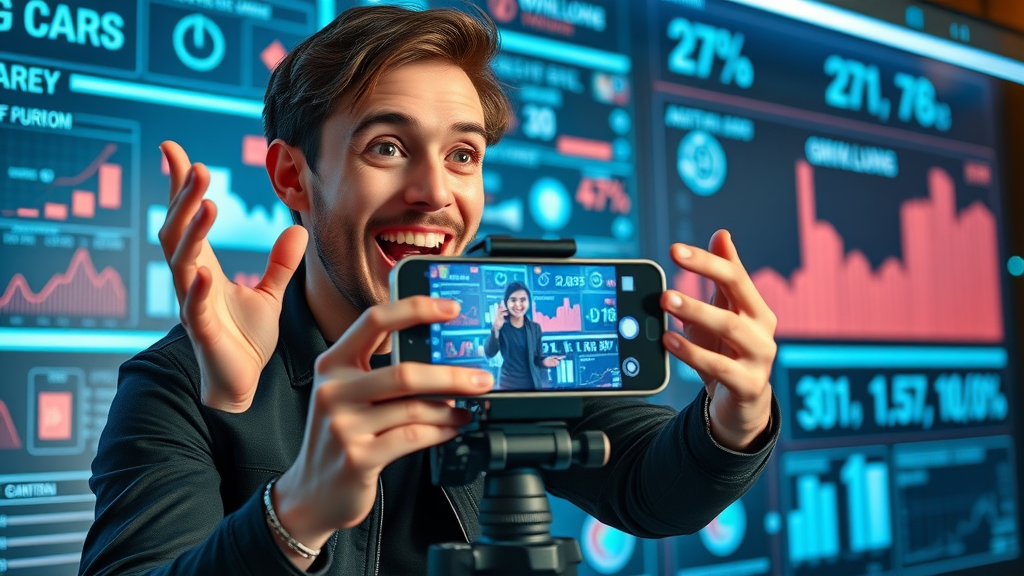Did you know that over 4.9 billion people use social media worldwide, yet less than 20% of brand posts reach their audience organically? If you want your content to actually matter, mastering the art of boosting social media reach is essential. In this comprehensive guide, you'll unlock unconventional secrets, practical strategies, and cutting-edge insights to increase your social media reach dramatically and accelerate your brand growth —starting today.
- Why social media reach matters in today's landscape
- How to harness the power of organic and paid reach
- Creative and actionable strategies for explosive growth
- Real-world examples and pro tips for instant wins
Unlocking the Power of Boosting Social Media Reach: Why It Matters Now More Than Ever
In 2024, boosting social media reach isn't a luxury—it's a necessity for brands looking to thrive. With so many users scrolling through endless feeds, standing out means leveraging every available tactic to get your content seen. Social media reach determines how many unique users lay eyes on your posts and ultimately drives your brand's relevance and bottom-line results.
Today, the difference between stagnation and rapid growth often comes down to a brand’s ability to wield media reach effectively. Whether you’re an established company or a fledgling startup, high social media reach directly influences brand awareness, audience engagement, and even search rankings. A post that resonates doesn’t just earn likes—it opens the floodgates to organic shares, viral moments, and valuable customer conversations across all media platforms .

Surprising Social Media Stats That Will Change Your Social Strategy
Consider this: 93% of marketers say social media accelerated their brand's exposure within months. The average organic reach of a Facebook post sits below 6%, making it clear that strategic intervention is needed. Additionally, brands that implement a content strategy specifically designed for shareability see engagement rates up to 60% higher compared to general posts. On platforms like Instagram, video content now boasts a reach rate 38% greater than static images.
These numbers underline a universal truth: the path to greater social media reach starts with creativity, consistency, and a willingness to adapt. Whether it’s leveraging live videos or optimizing when and where you post, every small tweak can produce major results. Understanding social media metrics, tracking engagement, and adapting your content strategy are keystones for outperforming the competition.
How Boosting Social Media Reach Drives Success: The Core Benefits and Quick Wins
Elevating your social media reach delivers both immediate and lasting advantages for your brand. Increased brand awareness means more people are becoming familiar with your product or service, driving future conversions. Higher engagement rates signal to algorithms—and to potential followers—that your brand is relevant and worthy of attention. This can lead to a self-perpetuating cycle: the more your content is shared and interacted with, the broader your media reach becomes.
By focusing on boosting social media reach, you also expand into untapped audiences and build credibility within your industry. As your posts appear in more feeds, you benefit from improved organic reach —which, in turn, reduces your need for paid promotion. What’s more, a strong social channel presence can accelerate campaign ROI, especially when paired with other media management tactics and influencer marketing partnerships.
- Increased brand awareness
- Higher engagement
- Enhanced conversions
- Expanded organic reach
- Credibility boost
“93% of marketers say social media accelerated their brand's exposure within months.”
Fundamentals of Social Media Reach: What Every Marketer Needs to Know
Before you can supercharge your results, you need a firm grasp of the basics of social media reach . This foundational knowledge helps you interpret your analytics and decide where to focus your efforts. Media reach refers to the total number of unique users who have seen your content, while organic reach counts those reached naturally, without paid promotion. The distinction matters because each type has a unique impact on your return on investment and marketing approach.
Effective media management means tracking the right set of media analytics , understanding platform algorithms, and strategically integrating paid and organic strategies. By mastering these fundamentals, you set the stage for measurable, scalable growth on any social platform, from Facebook and Instagram to TikTok, LinkedIn, or emerging networks.
Defining Media Reach vs. Social Media Reach
While often used interchangeably, media reach broadly measures the overall number of distinct audience members who encounter any type of content—traditional media (TV, print, radio) or digital (social, web). In contrast, social media reach specifically focuses on the unique users seeing your posts across social media platforms. This includes audiences from both paid campaigns (ads, sponsor posts) and organic efforts (unpaid, naturally shared content).
Understanding the difference is crucial for choosing the right media metrics to track and for evaluating which strategies best suit your goals—be it boosting visibility, maximizing your influencer marketing investment, or driving up your engagement rate. Always prioritize the channel that aligns closely with your brand’s target audience and content strengths.
Understanding Organic Reach in Social Media Content
Organic reach is the golden ticket for brands wanting sustained growth without a bottomless ad budget. It’s driven by factors like content relevance, timeliness, and audience engagement. Getting your social media content shared and seen by more people relies on creating value and tapping into social algorithms that reward authentic, high-engagement posts.
To maximize organic reach, focus your efforts on meaningful interactions—like encouraging comments, shares, and saves—rather than chasing vanity metrics. The more your audience genuinely interacts with your social posts, the more likely platforms are to push that content to a wider pool, snowballing your reach organically.

Crafting Social Media Content That Maximizes Reach
The type of content you share influences the size and quality of your social media reach. To break through algorithm-induced barriers, your social media content must be creative, relevant, and share-worthy. Employing a mix of text, images, videos, carousels, and stories ensures you’re reaching users in their preferred format, increasing the odds that your message will be spread even further.
Crafting a strong content strategy goes beyond simply posting—it means understanding what inspires your audience to share, like, comment, and come back for more. This proactive approach to media content production is key for any brand seeking to harness the full potential of social channels and accelerate results.
Creative Strategies for Shareable Media Content
Shareable media content starts with storytelling that resonates. Utilize behind-the-scenes glimpses, customer testimonials, interactive polls, or challenges that encourage user participation. Memes, how-to videos, and infographics also help break complex topics into digestible parts, powering up your engagement rate .
Don’t underestimate the power of emotional triggers. Content that elicits laughter, surprise, or inspiration gets shared most, especially when accompanied by visually compelling graphics. Incorporating trending topics or challenges—when done authentically—can also help your brand ride the wave of popular culture, effortlessly expanding your reach on major social platforms.

Optimizing Content Formats: Video, Images, Carousels, and More
Variety is critical for sustained audience engagement and maximized reach. Videos typically outperform static images, with live videos generating even higher organic reach on platforms like Facebook and Instagram. Carousels allow you to combine multiple images or messages in a single social post, increasing swipe-through rates and post longevity within feeds.
Experiment with different type of content: quick, informative Reels for Instagram, entertaining TikTok shorts, or professional LinkedIn pulse articles. By assessing what your audience prefers (using analytics tools and feedback), you can optimize your content calendar for continued growth and increased brand awareness.
Target Audience Mastery: Reaching the Right Followers For Amplified Social Media Reach
Knowing your target audience is non-negotiable for boosting social media reach. Audience insights guide everything from \content format\ to platform selection, and dictate which posts will resonate most. Focusing your social media strategy on audience-relevant topics ensures that your efforts compound over time, rather than being lost in the noise.
Using analytics tools to segment and analyze your audience not only saves effort but also allows you to personalize your messaging, which is proven to elevate overall media engagement and lead to more meaningful interactions across your chosen social media channels.
Using Analytics to Define and Segment Your Target Audience
Powerful analytics tools are at your disposal—inside platform dashboards (Meta Insights, Twitter Analytics, LinkedIn Analytics) and externally (Hootsuite, Sprout Social, Google Analytics). These platforms reveal who your real target audience is by showing when they’re online, what content type they engage with most, and which demographics convert best.
Refining your strategy based on these insights can dramatically improve your organic reach. For example, you may discover your posts resonate with an unexpected age group or geographic area, allowing you to tweak your tone, imagery, and scheduling to connect more authentically and increase your social media reach .

Personalization Tactics That Elevate Media Reach
Personalized content is king in today’s competitive landscape. Addressing your audience by name, tailoring offers to their interests, and referencing local or trending events in your niche helps your social posts feel relevant and relatable. Tools like dynamic content blocks, retargeting ads, and custom audience segments make these strategies scalable.
As you build a robust social media presence , replying to comments, sharing user-generated content, and tailoring your messaging based on media analytics insights show you value your followers, building equity and trust that lead to both higher engagement and share rates.
Timing is Everything: Posting Schedules for Maximum Organic Reach
No matter how stellar your content is, timing can make or break its success. Each platform has optimum posting windows—periods when your target audience is most active—for maximizing both organic reach and immediate interaction. Regularly analyzing your post-performance trends will allow you to identify these windows and schedule accordingly.
Frequency is just as important. Overposting can fatigue your followers, while posting too infrequently may result in your content being buried by competitors. The goal is to find your sweet spot, ensuring you show up consistently without overwhelming or underwhelming your audience.
Best Times to Post for Boosting Social Media Reach Across Platforms
Data-driven scheduling is essential for expanding your social media reach . For example, weekday mornings (Tuesday–Thursday, 9 a.m.–11 a.m.) work well for LinkedIn’s professional audience, while evenings and weekends drive higher engagement on TikTok and Instagram. Facebook and Twitter trends, meanwhile, fluctuate based on news cycles and geographic time zones.
Use native insights and third-party scheduling tools to track which posting times generate spikes in engagement rate and adjust your strategy periodically as user behavior shifts. This disciplined approach will keep you ahead of algorithm changes and audience fatigue.

Frequency Guidelines and Social Media Management Hacks
There’s no one-size-fits-all answer for posting frequency, but strong averages exist: 3–5 times weekly on Instagram, daily on Twitter/X, and at least twice weekly on Facebook. The key is consistency —sticking to a predictable, audience-approved cadence.
Use automation and batch-content creation to save time, maintain quality, and avoid burnout. Platforms like Buffer, Later, or Sprout Social streamline your efforts, enabling you to focus on engagement and content creativity instead of constant manual posting—a growth hack every social media manager should adopt.
Leveraging Platform Features: Stories, Reels, and Emerging Tools to Boost Social Media Reach
Today’s social platforms offer a suite of features—Stories, Reels, live videos, polls—that can turbocharge your media reach. Algorithms often prioritize these newer content types, positioning them front and center in user feeds and discovery panels. By experimenting with these tools, you benefit from increased visibility and deeper audience engagement.
Don't overlook emerging content formats or tools, such as Instagram Guides or LinkedIn Newsletters, which often provide early adopters with an advantageous bump in organic and paid reach alike.
Going Beyond Feeds: Getting Noticed in Algorithmic Spaces
Feed-based posting isn’t enough. Platforms like Instagram and Facebook now dedicate significant real estate to Reels and Stories, which boosts exposure and places your content in front of non-followers. Hashtag challenges, AR filters, and algorithmic “recommendations” further bolster your odds of going viral.
Taking the time to understand and use these features is essential for boosting social media reach —especially when organic reach from feed posts declines due to platform updates. Prioritize dynamic, video-driven formats, and collaborate with influencers who already excel in these spaces for even greater impact.

Integrating Live Video and Stories into Social Media Content
Live content stands out as one of the most powerful ways to reach your existing followers and attract new ones. On platforms like Facebook, Instagram, and TikTok, live videos often rank higher in algorithmic feeds and allow real-time interaction. Stories, with their short-lived yet highly visible nature, facilitate day-to-day engagement and help maintain top-of-mind awareness for your brand.
Combine live sessions and stories with polls, Q&As, or exclusive announcements to deepen audience connection and encourage greater media engagement. The immediacy and authenticity of live content make it a must-have tactic in every robust social media management plan.
Organic Reach vs. Paid Strategies: Striking the Optimal Balance
Relying solely on organic reach isn’t always practical—especially as platforms tighten algorithmic rules. Knowing when to “boost” a post with paid support can amplify high-performing content, achieve faster growth, and target audiences with pinpoint accuracy. However, a healthy balance remains vital: over-investment in ads can diminish authenticity and strain budgets.
A hybrid approach—investing in ads for launches or key campaigns, while cultivating organic reach for ongoing engagement—yields more resilient, sustainable results. Test, iterate, and analyze your social media metrics regularly to find a mix that works best for your unique goals.
When to Invest in Ads vs. Doubling Down on Organic Social Media Reach
Invest in paid media when launching new products, running limited-time offers, or attempting to break into new markets. Use organic strategies for building community, cultivating trust, and nurturing ongoing interaction. Remember that both approaches should funnel toward the same objective—expanding your overall media reach .
Continuously measure ad performance against organic post analytics to identify cost-effective ad spends. If a particular content type consistently generates great results organically, consider allocating budget to further amplify it to targeted audience segments .
Creative Budget-Friendly Paid Media Strategies
You don’t need a massive marketing budget to excel with paid reach. Retargeting campaigns, lookalike audience targeting, and micro-influencer partnerships each provide affordable ways to increase your social media reach without overspending. Take advantage of special ad credits, platform promotions, or beta-testing opportunities when available.
Combined with organic strategies, these cost-effective paid tools help maintain momentum and drive target audience engagement across all relevant social channels.
| Aspect | Organic Reach | Paid Media Reach |
|---|---|---|
| Cost | Free (time and effort-based) | Budget dependent |
| Sustainability | Long-term | Short-term |
| Audience Precision | Limited to followers and network | Highly targeted by demographics, interests, etc. |
| Credibility Building | High—authentic engagement | Lower—may appear as sponsored |
| Speed of Results | Slower | Immediate |
| Best Use | Community-building, trust | Promotions, launches, awareness spikes |
Building Community and Engagement: The Heart of Boosting Social Media Reach
Authentic engagement is at the core of any successful social media reach strategy. It’s not enough to simply broadcast a message—fostering two-way conversations, encouraging user participation, and building a sense of belonging empower your audience to become brand advocates. Communities drive amplification and continuous media reach growth by turning followers into collaborators.
Incorporating UGC (user-generated content) and responding quickly to messages or comments keeps your social channels dynamic and vibrant, signaling to the algorithms that your brand sparks genuine interaction and should remain highly visible.
Fostering UGC (User-Generated Content) and Community Collaboration
Sharing user posts, highlighting customer stories, and running hashtag campaigns are powerful ways to inspire content creation from your community. UGC not only increases social media engagement but also strengthens trust by showing real people using your product or service.
Collaboration can extend to cross-brand campaigns, influencer partnerships, or even collaborative content series that spotlight popular community voices. These tactics keep your brand on the radar—and put your followers front and center, which naturally increases media reach.

Responding to Comments and DMs: Why Engagement Drives Media Reach
Timely, thoughtful responses to comments and direct messages drive both media engagement and brand loyalty. Platforms reward accounts that respond and interact—helping you climb feed rankings and appear more often in “suggested” or “explore” sections.
Make engagement a daily habit: set aside time each day to reply to followers, acknowledge compliments, answer questions, and even address complaints. When your audience sees you value their input, they’re more likely to stick around, participate, and invite others into the conversation—ultimately broadening your social media presence .
Real-World Examples: Brands Excelling at Boosting Social Media Reach
Learning from the best is a shortcut to achieving similar results. Brands like Glossier, Wendy’s, and GoPro have built massive followings by embracing unconventional content formats, investing in user communities, and responding quickly to audience feedback.
For example, Glossier leverages UGC to crowdsource product ideas, while Wendy’s is famous for witty, on-brand responses that go viral. GoPro excels at using customer-shot footage to showcase their products in action, building credibility and reach organically.
- Case studies of brands dramatically increasing social media reach through innovative campaigns and consistent media management.
“Creativity and consistency are the engines of social media growth.”
Social Media Management Tools to Streamline Boosting Social Media Reach
Managing multiple social accounts and tracking results is overwhelming without the right tools. Today’s top social media management platforms offer features like scheduling, analytics, reporting, and performance tracking—all crucial for maximizing your time and results. Analytics tools help dissect what’s working best and guide data-driven changes to your content strategy.
From measuring engagement rate to optimizing post times, these platforms provide centralized dashboards for streamlining your media management and decision-making processes.
Essential Tools for Measuring Media Reach and Content Performance
Solutions like Hootsuite, Sprout Social, and Buffer offer comprehensive dashboards to track social media metrics , analyze content performance, and compare year-over-year growth. More advanced tools, like Brandwatch or HubSpot, combine media analytics and customer listening features to deliver even deeper insights.
Choose analytics tools according to your brand’s size, complexity, and content output. The right combination ensures you never miss actionable insights that could further boost your social media reach .

Automation and Scheduling Software for Social Media Management
Automation tools—ContentCal, Loomly, CoSchedule—help maintain posting consistency and free up time for community engagement or content creation. Customizable approval workflows, content libraries, and auto-queueing features ensure you meet every planned milestone with minimal stress.
By integrating these management solutions, even small teams can appear as polished and active as large enterprises, retaining focus on media content innovation and audience engagement rather than repetitive manual tasks.
| Platform | Key Features | Pricing (Monthly) | Pros | Cons |
|---|---|---|---|---|
| Hootsuite | Scheduling, Analytics, Multi-profile, Team Collaboration | $19–$99 | Robust features, strong integrations | Higher cost for advanced tools |
| Buffer | Easy Scheduling, Analytics, Affordable | $0–$99 | User-friendly, good for SMBs | Basic analytics in free tier |
| Sprout Social | Scheduling, Deep Analytics, CRM | $99+ | Excellent reporting, scalable | Costs can add up for teams |
| Later | Instagram-first, Visual Planning, Hashtag Analytics | $12.50–$50 | Great for visual content | Limited platforms in entry tier |
Maintaining Consistency: Plan and Execute a Winning Social Media Calendar
Consistency is the backbone of any successful social media management strategy. Building and following a content calendar preserves your brand voice, ensures audience expectations are met, and helps you track which tactics yield the highest media engagement. Use color-coding, planning apps, and set review dates to keep your social channel output on track.
This conscious, organized approach helps prevent missed opportunities and makes measuring success far easier. Ultimately, it allows for long-term, sustainable growth—even as algorithms or audience behaviors shift.
Tips for Sustainable Posting Without Burnout
Avoiding burnout is key for keeping your social accounts active and engaging. Batch-creating content, scheduling posts ahead, and repurposing high-performing content across multiple channels help maintain consistent output without sacrificing your work-life balance.
Don’t be afraid to take short breaks or pause output for strategic review. Regularly assess team bandwidth, solicit feedback, and automate where possible to prevent overwhelm and maintain the quality your audience expects.
Balancing Creativity with Consistency in Social Media Content
Creatively mixing up post formats, collaborating with new influencers, and adapting to fresh trends while staying true to your brand’s tone is essential. Review what competitors are doing—and what’s resonating in your space—to spark new ideas while maintaining consistent voice and messaging. This approach drives loyal, engaged followers and keeps your social channel lively and dynamic.
People Also Ask: What is the 5 5 5 rule on social media?
Explained: 5 posts, 5 comments, 5 interactions daily for social media growth
The 5 5 5 rule is a simple guide for daily social media growth: aim to publish five original posts, make five thoughtful comments on others’ content, and engage in five direct interactions (DMs or replies). Following this framework helps boost media reach and encourages regular engagement, ensuring you remain visible and active in your target community.
People Also Ask: How does social media increase reach?
Social algorithms prefer active, engaging content and reward share-worthy posts, expanding social media reach.
Social media increases reach by surfacing your posts to a wider audience when engagement is high. Algorithms prioritize content that’s actively shared, commented on, and saved. Focusing on quality, interaction, and timing will help you leverage these systems for maximum social media reach and visibility.
People Also Ask: What is the 50 30 20 rule for social media?
50% value content, 30% curated, 20% promotional—balancing this mix maximizes media reach.
The 50 30 20 rule recommends that half your content should provide value to your audience (tips, insights, tutorials), 30% should be curated (sharing industry news or partner content), and just 20% promotional (highlighting products or sales). Following this balance keeps your feed interesting and maximizes both engagement and overall media reach .
People Also Ask: What are the 7 C's of social media?
Content, Community, Communication, Connection, Conversion, Consistency, Creativity are the seven pillars for media management success.
The 7 C’s of social media lay the groundwork for success in media management: Content, Community, Communication, Connection, Conversion, Consistency, and Creativity. Each plays a central role in shaping your strategy, driving engagement, and fueling ongoing social media reach growth.
Pro Tips and FAQs on Boosting Social Media Reach
- How often should you update your posting strategy for optimal media reach? Review your approach quarterly—adapt sooner if trends or performance shifts.
- Is it better to focus on one platform or diversify? Start with 1–2 platforms where your target audience is most active, then expand once you master those spaces.
- What content goes viral more quickly? Emotional, interactive, and visually dynamic posts—especially video and UGC—often go viral fastest.
- How can beginner brands leverage influencers to boost social media reach? Partner with relevant micro-influencers on collaborative campaigns for instant trust and expanded media reach .
Recap and Next Steps for Elevating Your Social Media Reach
- Audit your current social media presence
- Set concrete goals for boosting social media reach
- Measure, iterate, and invest in both organic and paid strategies
- Stay ahead with emerging platform features
Ready to Start Boosting Social Media Reach? Implement These Secrets Now!
Start boosting your social media reach by auditing your media presence, implementing these actionable secrets, and watching your audience grow. Your next viral post—and big breakthrough—are just a few clicks away!
To further enhance your understanding of boosting social media reach, consider exploring the following resources:
-
“Quit Boosting Posts! 7 Ways to Improve Your Organic Reach on Social Media” : This article offers practical strategies to enhance your organic reach, such as cross-promotion, forming partnerships with publishers, diversifying content formats, leveraging platform-specific features like Instagram Reels and Facebook Stories, utilizing data analytics, and repurposing successful content. ( socialtoaster.com )
-
“Get More Eyes on Your Content: How to Increase Your Social Media Reach” : This piece emphasizes the importance of strategic experimentation, optimizing content for social SEO, effective use of hashtags and location tags, collaborating with influencers, engaging in live sessions, and tapping into trending topics to expand your audience. ( sendible.com )
By delving into these resources, you’ll gain actionable insights and innovative strategies to effectively boost your social media reach.
 Add Row
Add Row  Add
Add 




Write A Comment